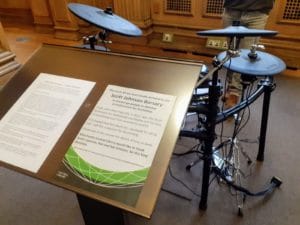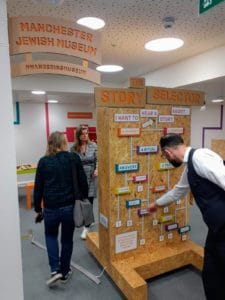Een makelaar vertrouwde mij ooit toe dat een boekenkast in de woonkamer duizenden euro’s scheelt in de verkoopwaarde van een huis. In negatieve zin. Dit weetje doet het altijd goed op feestjes, en boekenliefhebbers (mijn netwerk zit er vol mee) gruwen ervan. Bij een rondleiding in de Centrale Bibliotheek van Manchester vertelde de hoofdbibliothecaris ons vol trots dat het café van de vernieuwde, veel toegankelijker bibliotheek zo goed liep omdat er nergens boeken te zien waren.
Ik ging in februari naar Manchester en Liverpool om dingen te leren. Nieuwsgierigheid bracht mij, met een twintigtal ondernemers en managers uit de cultuursector, naar de tweede stad van Engeland. Bijna 3 miljoen mensen telt de Greater Manchester Area, een stedelijke regio vergelijkbaar met onze Rijnmond: een ‘openbaar lichaam’ dat al sinds mensenheugenis geregeerd wordt door Labour.
Hoogaltaar

De Manchester bieb, in een betonnen pantheon uit 1934 dat, anders dan Dr Who’s Tardis, van buiten groter lijkt dan die van binnen is, dankzij een geinige truc met de koepel, is sinds de heropening in 2014 in ieder geval een succes. Na een vier jaar durende verbouwing is nu, in plaats van voorheen 30, 70 procent van het gebouw voor het publiek toegankelijk. Pièce de résistance is de studiezaal onder de gigantische koepel, waar alleen nog in serene stilte gestudeerd wordt. De als een hoogaltaar vormgegeven uitleenbalie is niet meer bemand. De zaal is razend populair bij scholieren, die er de rust vinden die in de rest van deze hectische, postindustriële stad ontbreekt. In tijden van schoolexamens zit de zaal bomvol.

Naast de studiezaal is de mediatheek te vinden, met een oefendrumstel. Erfstuk van de verongelukte drumtechnicus van Radiohead. Eens in de zoveel tijd zijn er jam-sessies.
Joods Museum

De boeken zijn verhuisd naar de kelder. Hier geen gewijde stilte maar kinderstemmen, al blijven die brits beheerst. De bieb is een perfecte speeltuin voor gestreste (groot)ouders, die hun kinderen er vrij kunnen laten rondlopen. Er lopen voorlezers rond, en er zijn boekenkasten vol werken in veel van de 200 talen die in Manchester gesproken worden. Op de begane grond is ruimte voor pop-up shops en tijdelijke exposities van gemeentelijke instellingen, zoals nu het Joods Museum, dat in een buitenwijk ligt en tijdelijk gesloten is.
Het bezoek is enorm toegenomen, het gebouw zindert van het leven. Het uitlenen van boeken is niet langer de hoofdtaak van de bibliotheek. De Studiezaal zit vol, de popup cultuurshop wordt onder de voet gelopen door een klas geüniformeerde schoolkinderen. In het gedeelte, gereserveerd voor ondernemers en start-ups, zitten een paar sjofele oude mannen te dutten, achter een exemplaar van The Guardian. Ook Manchester heeft ontdekt dat de bibliotheek de huiskamer van de stad moet zijn. Het is gelukt in een oud gebouw, niet met nieuwbouw, zoals bij ons in Amersfoort, Groningen of Tilburg, waar nieuwbouw ongekende mogelijkheden bood.
Manchester kon niet meer trots zijn op de bibliotheek, toen de betonnen kathedraal vooral zijn eigen rug, en de ruggen van boeken aan de bevolking liet zien. De investering die de gemeente deed, om het gebouw niet alleen te restaureren, maar vooral ook te revitaliseren, zorgt ervoor dat Mancunuians weer trots zijn op het gebouw, dat nu het decor vormt van stadse feesten en plechtigheden. Dat inspireert.
Eerdere delen:
Volgende delen zijn:
